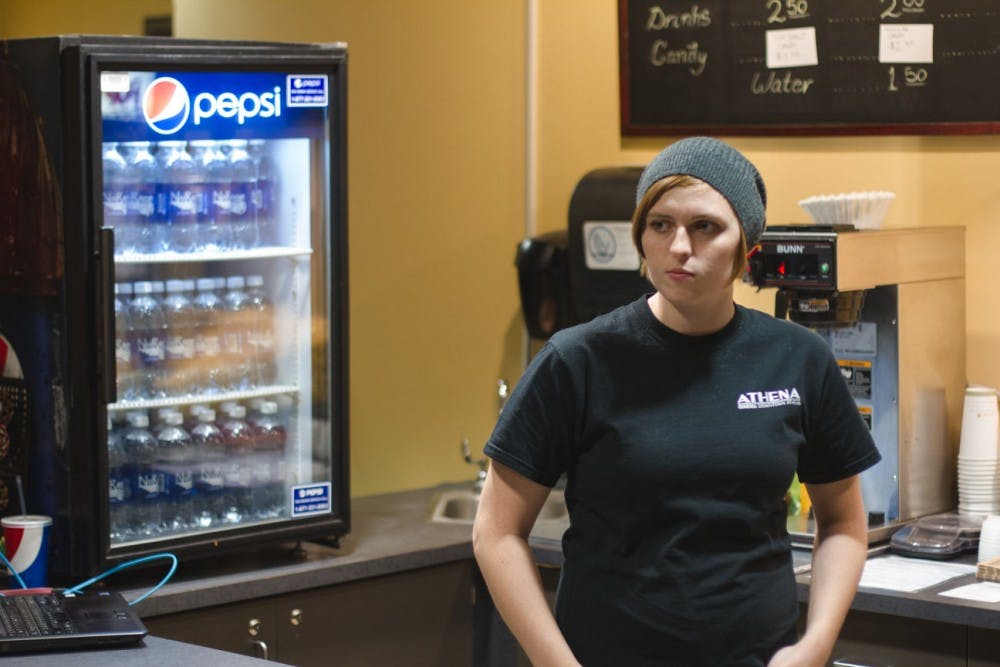Editor's Note: This week, The Post is publishing a series exploring student debt at Ohio University. This is the first story of the five part series.
Megan Popke has to work five minimum wage jobs to fulfill her dream of helping other people by becoming a nurse at Saint Jude Children’s Research Hospital.
Adam Wise is a freshman cross country runner who received athletic and academic scholarships but still had to take out private loans to afford his first year in school.
Eli Chambers works as a barista at Whit’s Frozen Custard to fund the trips he takes with his band while he goes to school to become a professional.
Popke, Wise and Chambers are some of the many students at Ohio University who are trying to pay for school while borrowing money and incurring as little debt as possible.
Securing a job, often at minimum wage, is a way some students have managed to minimize their loans.
A student from Ohio would have to work about 35 full-time weeks at minimum wage to pay for a year of school in 2015, excluding taxes.
Ohio raised the state minimum wage from $7.95 to $8.10 at the onset of 2015, and a year of tuition for an in-state student is $10,380.
OU’s Board of Trustees, its governing body, has said that student affordability is a priority, according to university documents.

But university officials have made it impossible to work more than 20 hours per week on campus, citing the potential for the workday to interfere with schoolwork, according to a previous Post report.
So, if a student wanted to work a full-time job, he or she would have to work at an uptown establishment.
Minimum wage has been increasing nationwide, from $2.65 in 1978 to the current $7.25 federal minimum wage. But while the hourly wage has increased, the buying power has decreased.
Minimum wage increased by $4.60 since 1978, but the buying power decreased by $2.37 since that year, according to the United States Bureau of Labor Statistics.
That means minimum wage has not increased as fast as inflation; an hour of work in 1978 was worth more than two dollars less than an hour of work today.
Money buys less, but an OU education is more expensive than it was in the 1970s.
In the 1970s, it was possible to pay for a college degree with a minimum wage job.
A student could work 40 hours a week at minimum wage for a little more than 17 weeks, roughly the length of time students are currently on summer break, to pay for the next year of school.
OU increased its tuition $6,621.50 since 1978, after adjusting for inflation. In comparison, Miami University increased its tuition by about $12,000 since 1980.
Students who do borrow money to pay for an OU education often can’t pay back the loans.
OU students had the second highest default rate — the number of students who go nine months without making a loan payment — on their student debt among large, public, four-year institutions in 2011, according to the U.S. Department of Education and a previous Post article.
“Money is tight,” Chambers said.
Higher education institutions have a tough time balancing budgets as well, according to rating agencies. Even though universities have attempted to adapt to weaker economic conditions, uncertain funding and federal regulatory environments overpower strengths in the education sector, Moody’s Vice President Eva Bogaty stated in the organization’s most recent study of higher education.
"Affordability remains a key issue as the weak economic environment continues to affect families' ability to pay for higher education,” Bogarty said.

OU officials know it can be difficult to pay for school.
The Board of Trustees is brainstorming ways to make college affordable, while balancing its own budget.
“From an affordability standpoint, the board has looked for ways to mitigate (rising costs) and to make it possible,” Trustee Chair David Brightbill said, in a previous Post report.
One proposed solution to the problem the board suggested would be to grow sources of university revenue, such as the endowment. The endowment recently eclipsed $500 million, and the university hopes to grow it past $1 billion, according to a previous Post report and university documents.
Some students have asked the university for a tuition freeze, a $15 minimum student wage on campus, and the ability to work more hours each week.
Others find these requests unreasonable, including Popke who thinks their ideas are a bit idealistic.
“I think (a $15 minimum wage) is a decent idea, just because the cost of living has gone up the past few years, but I think it’s just going to cause everything else to jump up in price,” Popke said. “I guess you could say its kinda bittersweet.”
"I think it’s just going to cause everything else to jump up in price," - Popke on a minimum wage increase.
And many students have to settle for those minimum wage jobs — or jobs that fall close to that pay scale — while they work to acquire the skills needed for better employment.
OU is one of the largest employers of students in Athens. Though most positions are minimum wage, it is possible to receive a raise.
Many students, such as resident assistants and student leaders — those in higher-level positions in Culinary Services and Campus Recreation, for example — are paid above the minimum wage, but even some of those students are unsatisfied. This semester, many RAs on campus worked to form a union to better negotiate higher wages and other benefits with the university, according to a previous Post report.
But there aren’t enough higher-paying university jobs to help many at OU avoid large sums of debt.
Popke, a sophomore, has already racked up between $30,000 and $40,000 in debt from numerous loans.
“It’s like juggling; you’re trying not to drop anything because if you let one thing slip, everything will come tumbling down,” Popke said.
That doesn’t crush her spirit, however. She’s been used to taking care of others from a young age; her mother died of breast cancer in 2008, when she was just entering her teenage years, so she feels more than capable of taking care of herself.
“I had to learn how to take care of a parent who was dying,” she said. “And my brother has Down syndrome, so it’s kinda like taking care of two people at the same time.”
In order to fulfill her dream of helping others by working at St. Jude’s, she has worked countless hours at a wide range of jobs, just so she could have the chance of scraping by while earning her degree.
“Everyone is going to have their own disadvantages and their own problems,” she said. “But someone is always going to have it worse, and you can always help that person and bring them up.”
And she has complete confidence in her chances of getting out from under the weight of all those loans.
“(I) see myself paying off my debt, definitely,” she said.
@SethPArcher
Sa587812@ohio.edu





